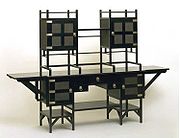
Sideboard (Edward William Godwin)
Encyclopedia

Edward William Godwin
Edward William Godwin was a progressive English architect-designer, who began his career working in the strongly polychromatic "Ruskinian Gothic" style of mid-Victorian Britain, inspired by The Stones of Venice, then moved on to provide designs in the "Anglo-Japanese taste" of the Aesthetic...
(1833–86), who was one of the most important exponents of Victorian
Victorian era
The Victorian era of British history was the period of Queen Victoria's reign from 20 June 1837 until her death on 22 January 1901. It was a long period of peace, prosperity, refined sensibilities and national self-confidence...
'Japonisme', the term used to describe the appreciation and appropriation of Japanese artistic styles. Japan began trading with the West in the 1850s, and by the next decade imported Japanese prints (Ukiyo-e
Ukiyo-e
' is a genre of Japanese woodblock prints and paintings produced between the 17th and the 20th centuries, featuring motifs of landscapes, tales from history, the theatre, and pleasure quarters...
), ceramics and textiles were very fashionable in Britain. Godwin was influenced by interiors depicted in Japanese prints and by the studies he made of Japanese architecture, but he did not seek to imitate Japanese designs. Instead his Anglo-Japanese furniture aimed to combine the more general principles of simplicity and elegance he admired in the art of Japan with domestic needs of the Victorian home.
The sideboard is stylish and dramatic, but it is also quite appropriate for use in a dining room. It is functional with drawers, adjustable shelves, and a rack fitted to take a large dish between the cupboards. The construction and finish are practical and hygienic, with hard surfaces and simple decoration, and the raised bottom shelf gives access for cleaning the floor.
Godwin designed the first version of this sideboard in ebonised
Ebony
Ebony is a dense black wood, most commonly yielded by several species in the genus Diospyros, but ebony may also refer to other heavy, black woods from unrelated species. Ebony is dense enough to sink in water. Its fine texture, and very smooth finish when polished, make it valuable as an...
deal
Deal
Deal may refer to:Places* Deal, Kent, a town in Kent, England* Deal, New Jersey, a borough in Monmouth County, New Jersey, United States* Deal Island * Deal, a village in Câlnic Commune, Alba County, RomaniaAs a surname...
, a cheap wood, in 1867. He subsequently changed to ebonised mahogany
Mahogany
The name mahogany is used when referring to numerous varieties of dark-colored hardwood. It is a native American word originally used for the wood of the species Swietenia mahagoni, known as West Indian or Cuban mahogany....
, as he found deal to be unstable. At least ten versions of the original were made between 1867 and 1888, with differences in design, in decoration or in the number of legs. There are several surviving examples of this sideboard, made of ebonised deal, mahogany, or oak
Oak
An oak is a tree or shrub in the genus Quercus , of which about 600 species exist. "Oak" may also appear in the names of species in related genera, notably Lithocarpus...
and pine
Pine
Pines are trees in the genus Pinus ,in the family Pinaceae. They make up the monotypic subfamily Pinoideae. There are about 115 species of pine, although different authorities accept between 105 and 125 species.-Etymology:...
. The original sideboard was designed by Godwin for the dining room of his London home in 1867.

